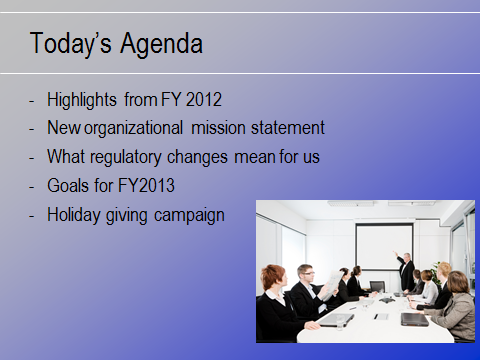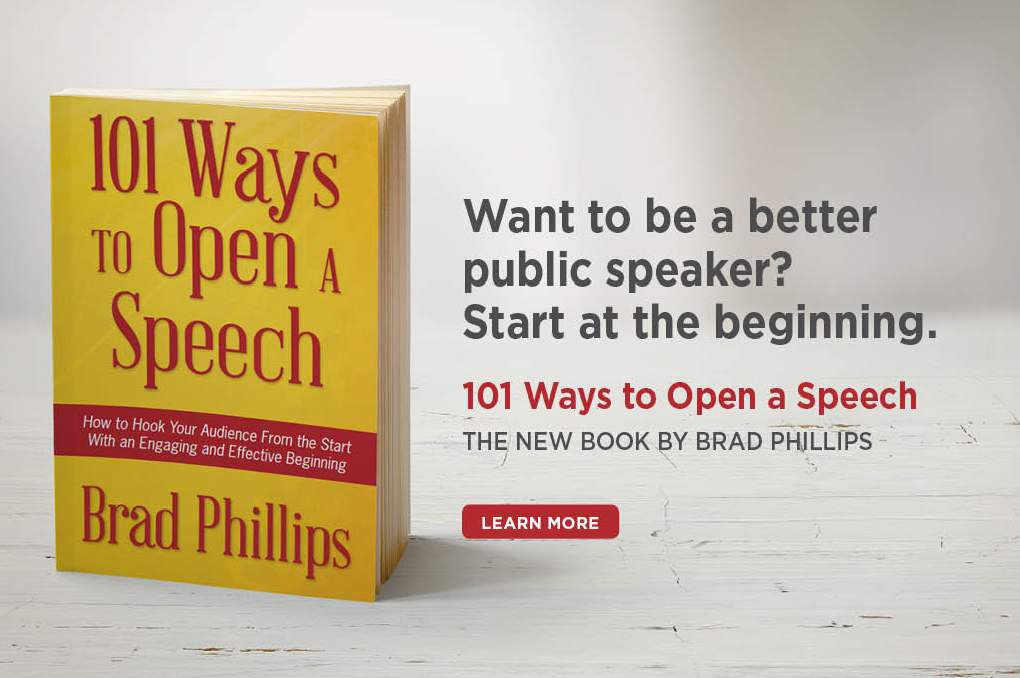The PowerPoint Slide I Hate The Most
If there’s one part of a speech I hate the most, it’s the agenda slide most speakers present at the very beginning of their talks.
How many times have you seen an intro slide that looks something like this?

I have at least three problems with that type of agenda slide:
1. It Doesn’t Get The Audience “In The Tent”
The opening minutes of a presentation are often the most important. According to Allan and Barbara Pease, authors of The Definitive Book of Body Language, the audience forms 60—80 percent of its impression of a speaker within the first four minutes of a speech. This slide does nothing to create a positive impression.
2. It Makes PowerPoint The Star
At the beginning of a speech, you should establish yourself as the main attraction. Why would you want to share credit with a screen?
3. It’s Low Value
Worst of all, that type of agenda slide isn’t even close to the most compelling way to share that information.

But since it’s often a good idea to give the audience a sense of what material you plan to cover, what should you do?
First, kill the agenda slide. You can cover the agenda verbally.
Second, don’t begin your speech with the agenda. Open with something more interesting—a compelling story or statistic, for example (here are eight great ways to open a speech). When you’ve finished the opening, then deliver your agenda.
Third, make it short. Most agendas don’t require lengthy explanations. If you can accomplish your entire agenda in one sentence, do it:
“So today, we’ll discuss what we learned in 2012 and how those lessons led to changes in our mission statement; and we’ll talk about our goals for 2013 and how some new regulatory changes will affect the way we accomplish them.”
Fourth, consider whether you really need an agenda at all. For presentations in which you’re telling a story that builds to a rousing conclusion, an “agenda” might undercut your closing and make your conclusion less impactful.
Have the best of the blog delivered to your inbox twice per month! Enter your name in the box below to join our mailing list.



I’d argue that if you need to tell your audience why they’re there in the first place, you’ve failed in setting up your meeting.
That’s likely truer for some types of meetings than others, but you make an interesting point.
Great point. I agree 100% with this — even though I’ve had my own agenda slides in the past. NO MORE. From now on, I’ll start with a story.
(The other BAD way to begin a speech is with a lame joke. So many people make this error!) Stories rule. Start with a story!
Daphne,
Thanks for your comment. I completely agree with you on the story opening – it’s my favorite, as well.
Best wishes,
Brad
Hi Brad,
First let me say you have the best web site in your field. I just shared your “front page” with my colleagues as one to admire.
Re agenda slides:
1. Always say more than you show
2. Show very little
3. Some listeners may feel reassured seeing a structured agenda- I agree with you that most agenda slides have zippo energy
4. Yes, you should be the most important visual in the room
Thanks for all Brad.
Laurie
Laurie,
That’s incredibly kind. Thank you very much for reading and for your nice words.
I agree completely with your list, and was particularly struck by your third point. You’re exactly right that certain types of learners demand structure, so giving a road map for your presentation is often a good idea. Personally, I prefer to do that verbally. I want all eyes on me for the first five minutes of any presentation – which, among other things, helps me assess the body language of who’s already in and who I’m going to have to work to earn.
Thanks again, Laurie.
Best,
Brad
I am in total agreement with this post, Brad. The way I like to get presenters thinking about this point is that an agenda slide starts off the presentation by telling the audience about what is important to you as a presenter. “I am going to talk about this subject, the next subject, and another subject.”
You need to flip the psychology to the audience’s point of view. “Why should you care enough about this topic to listen to me for the next x minutes?” “What value are you going to get from this presentation?”
Those establishing propositions don’t focus on the content that will be delivered. They concentrate on the audience’s desire to take away something useful. The content will follow naturally once they buy into the importance and relevance of the presentation for themselves rather than for the presenter.
All so true. Everything a speaker does should be about adding value for the audience.
I reckon there’s nothing much duller than a list, and agendas are right up there with the likes of shopping lists and laundry lists!
You might also like these 3 options you can use to structure your talk without an agenda slide. (In each one, there’s an example of exactly what you might say when you start your talk.) Would love to hear what you think.